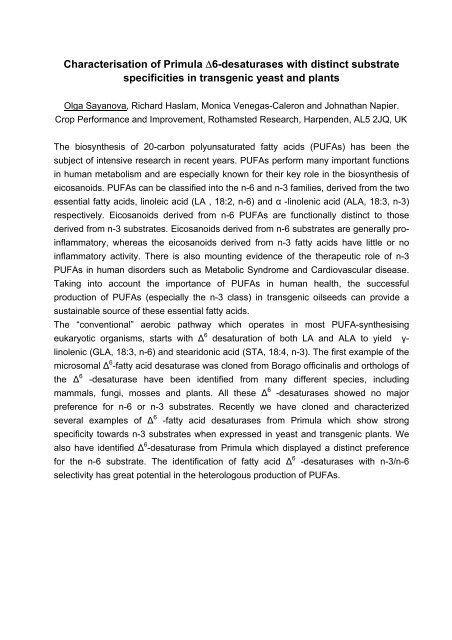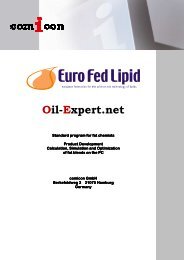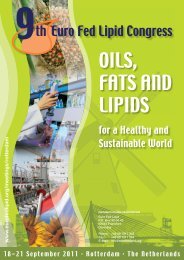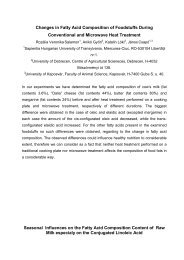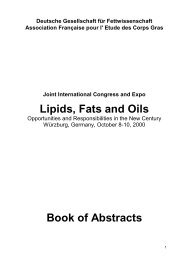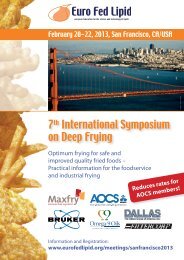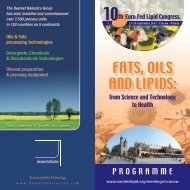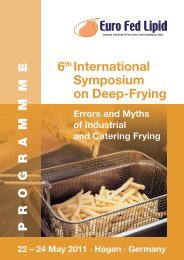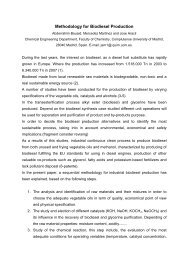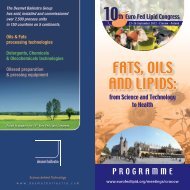Abstracts now available online - Euro Fed Lipid
Abstracts now available online - Euro Fed Lipid
Abstracts now available online - Euro Fed Lipid
Create successful ePaper yourself
Turn your PDF publications into a flip-book with our unique Google optimized e-Paper software.
Characterisation of Primula ∆6-desaturases with distinct substrate<br />
specificities in transgenic yeast and plants<br />
Olga Sayanova, Richard Haslam, Monica Venegas-Caleron and Johnathan Napier.<br />
Crop Performance and Improvement, Rothamsted Research, Harpenden, AL5 2JQ, UK<br />
The biosynthesis of 20-carbon polyunsaturated fatty acids (PUFAs) has been the<br />
subject of intensive research in recent years. PUFAs perform many important functions<br />
in human metabolism and are especially k<strong>now</strong>n for their key role in the biosynthesis of<br />
eicosanoids. PUFAs can be classified into the n-6 and n-3 families, derived from the two<br />
essential fatty acids, linoleic acid (LA , 18:2, n-6) and α -linolenic acid (ALA, 18:3, n-3)<br />
respectively. Eicosanoids derived from n-6 PUFAs are functionally distinct to those<br />
derived from n-3 substrates. Eicosanoids derived from n-6 substrates are generally proinflammatory,<br />
whereas the eicosanoids derived from n-3 fatty acids have little or no<br />
inflammatory activity. There is also mounting evidence of the therapeutic role of n-3<br />
PUFAs in human disorders such as Metabolic Syndrome and Cardiovascular disease.<br />
Taking into account the importance of PUFAs in human health, the successful<br />
production of PUFAs (especially the n-3 class) in transgenic oilseeds can provide a<br />
sustainable source of these essential fatty acids.<br />
The “conventional” aerobic pathway which operates in most PUFA-synthesising<br />
eukaryotic organisms, starts with ∆ 6 desaturation of both LA and ALA to yield γlinolenic<br />
(GLA, 18:3, n-6) and stearidonic acid (STA, 18:4, n-3). The first example of the<br />
microsomal ∆ 6 -fatty acid desaturase was cloned from Borago officinalis and orthologs of<br />
the ∆ 6 -desaturase have been identified from many different species, including<br />
mammals, fungi, mosses and plants. All these ∆ 6 -desaturases showed no major<br />
preference for n-6 or n-3 substrates. Recently we have cloned and characterized<br />
several examples of ∆ 6 -fatty acid desaturases from Primula which show strong<br />
specificity towards n-3 substrates when expressed in yeast and transgenic plants. We<br />
also have identified ∆ 6 -desaturase from Primula which displayed a distinct preference<br />
for the n-6 substrate. The identification of fatty acid ∆ 6 -desaturases with n-3/n-6<br />
selectivity has great potential in the heterologous production of PUFAs.


